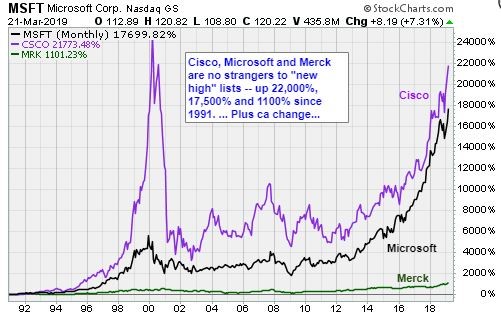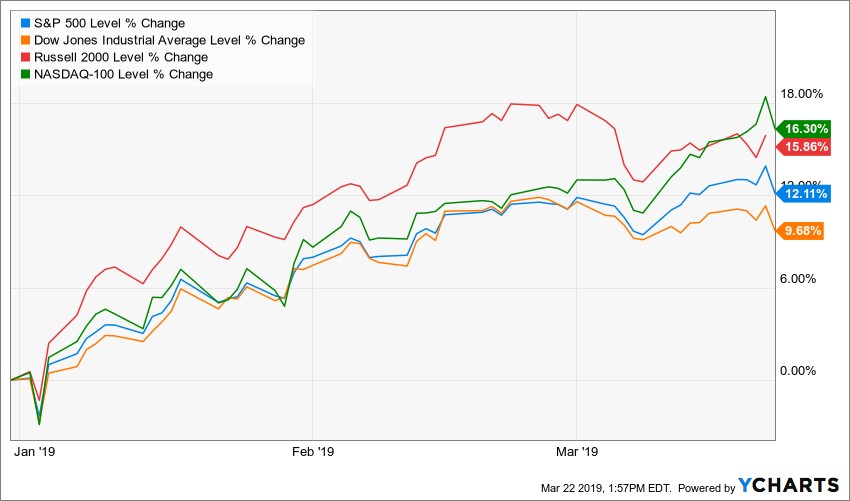Stock markets take wing after Fed pulls off its dovish stunner
Demand for tech stocks swept the Street over the past week as investors decided to go all-in for risk following a Federal Reserve decision on interest rates that could not have been more dovish had it sprouted wings.
Topping the new high list at the close of the week were Microsoft (MSFT), Cisco Systems (CSCO) and Merck (MRK). It was like the late 1990s all over again.
Others included Salesforce.com (CRM), back from a dip, as well as PayPal (PYPL), Danaher (DHR), Next Era Energy (NEE), American Tower (AMT), Mondelez (MDLZ), Intuit (INTU) and Crown Castle International (CCI). This is a good vanguard of growth and digital transformation.
The gains underscore investors’ willingness to snap up riskier stocks as long as the Fed maintains a more accommodative stance on monetary policy.
Stocks have been rallying most of the year, but the gains have been interrupted by periods of uncertainty around the Fed’s pace of interest-rate hikes, as well as worries about the U.S.’ trade spat with China.
Wednesday’s press conference following the Fed’s two-day meeting removed a major source of uncertainty from investors’ minds, easing the pathway for major indexes to hit new highs.
The central bank’s revised forecasts now indicate zero interest-rate increases in 2019.
The Fed also announced it would begin tapering its balance sheet runoff process and end it entirely in September.
One longtime observer said that “like the old Claymation character Gumby, the Fed will allow the economy to stretch a bit, and will do so by maintaining the hiking pause for now, by running a larger balance sheet going forward than previously assumed, and by allowing higher inflation expectations to build.”
I wonder how long it will take the Fed to rev up the QE machine again, if its forecast of a weakening economy proves accurate. Quantitative easing is the crack heroin of monetary policy; it’s hard to quit.
It’s a little hard to believe. but the S&P 500 Index is now up 14% on the year, while the Nasdaq is +18% and the Russell 2000 is +16%. Further, the S&P 500 is now only around 3% below its all-time high of 2,931 on Sept. 20, 2018.
That’s the good news. The bad news is that equity valuations no longer appear cheap.
With the S&P 500 trading above 16x consensus forward earnings estimates and the positive effects of a U.S.-China trade deal already priced in, there is no room for disappointment.
You should definitely be participating with ETFs and growth stocks, but also keeping a wary eye on the exit.
Or maybe we should all just relax, considering …
Mo’ momentum
Action over the past week shows that buyers are showing little interest in fading away now that the indexes have almost closed the gap at their 2018 highs. The S&P 500 has gone from a 20% decline to coming within 3% of its record high.
Market research savant Jason Goepfert of SentimenTrader.com says this is one of the quickest turnarounds in the index’s history. And the few other times it enjoyed a recovery like this, it just kept right on going.
Goepfert scanned his database for every time the S&P 500 went from at least a 19.5% drawdown from a multiyear high to a recovery of within 3% of that high, with the recovery occurring within six months of its low.
The only one, other than our current one, that triggered within three months was the legendary bottom in October 1982 — “so we have some good company there,” he said.
Even though the other similar recoveries weren’t as impressive, they still led to mostly positive returns going forward, with a notably small level of risk.
The average gain forward two months was 4.1% and the average 12-month gain was 16.4%.
Over the following six months, only one of the signals suffered a loss of more than 4% at its worst point.
All but one of the signals managed to close at a new multi-year high within 30 trading days.
Bottom line: Despite political or economic negatives in each case, buyers have ignored them en route to a remarkable positive reversal.
It’s tempting to suggest the recovery has been “too much, too soon.” But the few precedents that exist would argue it’s not.
Best wishes,
Jon D. Markman






